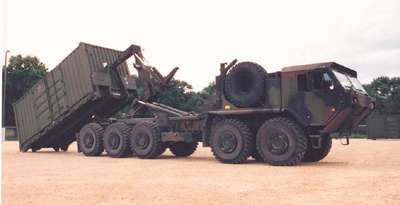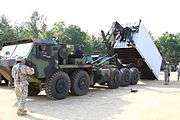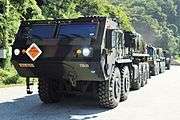Palletized load system
| Oshkosh Palletized Load System (PLS) | |
|---|---|
|
Oshkosh M1074A1 Palletized Load System (PLS) truck in B-kit configuration and with an Oshkosh Container Handling Unit (CHU) | |
| Type | 10×10 heavy tactical truck |
| Place of origin | United States |
| Service history | |
| In service | 1993–present |
| Used by | U.S. Army, Israel, Jordan and Turkey [1][2] |
| Production history | |
| Designer | Oshkosh Corporation |
| Designed | 1989 |
| Manufacturer | Oshkosh Corporation |
| Produced | 1992–present |
| Number built | 6288 PLA A0 and >2150 PLS A1 (A1 figure includes A0 Recap to A1 standard), plus > 15,000 PLS trailers |
| Variants | M1074A0, M1075A0, M1074A1, M1075A1 |
| Specifications (M1075A1) | |
| Weight | 24,040 kg (unladen with flatrack); 39,009 kg (GVWR); 61,462 kg (GCWR) |
| Length | 10.795 m[3] |
| Width | 2.517 m[3] |
| Height | 3.277 m (LHS hook)[3] |
| Crew | 2 |
|
| |
| Armor | a-kit/b-kit; U.S. Army Long Term Armor Strategy (LTAS) compliant |
| Engine |
Caterpillar (CAT) C15, 15.2-liter, 6-cylinder inline water-cooled diesel[3] 600 hp (450 kW) |
| Payload capacity | 14,965 kg (16.5 tons) on flatrack[3] |
| Transmission | Allison 4500SP 5-speed automatic with Oshkosh 36000 Series 2 speed transfer case[3] |
| Suspension | Oshkosh TAK-4 fully independent coil on axles 1 and 2, Hendrickson RT-400 walking beam on axles 4 and 5, rear Hendrickson-Turner air ride suspension on mid-axle (3rd)[3] |
| Speed | 62 mph (100 km/h)[3] |
Steering system | Power-assisted on front tandem[3] |
The Palletized Load System (PLS) is a truck-based logistics system that entered service in the United States Army in 1993. It performs line haul (long distance), local haul (short distance), unit resupply, and other missions in the tactical environment to support modernized and highly mobile combat units. It provides rapid movement of combat configured loads of ammunition and all classes of supply, shelters and containers. It mirrors similar systems in use with the British (Demountable Rack Offload and Pickup System (DROPS)) and other armed forces.[4]
History
In January 1989, the U.S. Army Tank Automotive Command (now TACOM Life Cycle Management Command) awarded prototype Palletized Load System (PLS) contracts to Oshkosh Truck Corporation, the PACCAR Government Group and General Motors, Military Vehicle Operations, with each contractor to deliver nine trucks, six trailers, and 30 flatracks for prototype hardware testing which began in September 1989. Oshkosh Truck Corporation was awarded a five-year contract for PLS in September 1990, with production commencing in 1992.)[4]
The original contract award was for 2626 PLS trucks, 1050 M1076 PLS trailers, and 11,030 M1077 PLS flat racks. Under the initial PLS contract, between 1992-1997 Oshkosh delivered 2905 PLS trucks and 1534 PLS trailers. Around 50 per cent of the PLS trucks were fitted with a Grove material handling crane and were designated M1074. PLS without the crane are designated M1075.[3][4]
Between 1997 and 2001, Oshkosh Truck Corporation delivered a further 595 PLS trucks and 800 PLS trailers, increasing fleet size to 3,500 trucks and 2,334 trailers.[4]
In March 2001, Oshkosh Truck was awarded the Family of Heavy Tactical Vehicles (FHTV) contract. FHTV included provision for up to 740 PLS trucks and 1060 PLS trailers. The FHTV contract was extended twice, following which FHTV2 was awarded to Oshkosh Truck. In October 2008 FHTV 3 was awarded to Oshkosh Defense. In addition to PLS and PLS trailers, FHTV covers deliveries of Oshkosh Heavy Expanded Mobility Tactical Truck (HEMTT) and Heavy Equipment Transporter (HET). As part of the FHTV 3 contract, Oshkosh commenced deliveries of PLS in A1 configuration.[4]
The last of 6,288 production PLS A0 was delivered in December 2009.[4]
Oshkosh announced in January 2012 that it had been awarded a bridge contract by the U.S. Army to continue FHTV production. Under this extended contract, the government could place orders through October 2013 and Oshkosh Defense could deliver through September 2014. By mid-2013 more than 2,150 PLS A1 and nearly 15,000 PLS trailers had been built.[4]
On 19 June 2015 Oshkosh Defense announced the company had been awarded a five-year requirements contract by the U.S. Army to Recapitalize its Family of Heavy Tactical Vehicles (FHTV). The potential value of the contract is $780 million and it covers an estimated 1,800 FHTVs. All work performed under the contract will be completed in Oshkosh, Wisconsin, with deliveries occurring from 2015 to 2019. Under the contract, in addition to Heavy Expanded Mobility Tactical Trucks (HEMTT), PLS trucks, will be Recapitalized to the latest model configuration and the same zero-mile, zero-hour condition as new production vehicles. The contract also includes the production of approximately 1,000 PLS trailers. In March 2016 Oshkosh received FHTV 4 awards valued at $430 million and covering the Recap of 1212 HEMTTs and PLS, plus the production of 345 new-build PLS trailers. Deliveries are slated for 2016-2017. Oshkosh has worked with the Army to restore more than 12,000 heavy vehicles since 1995.[5]
Through recapitalization, used vehicles are returned to Oshkosh Defense, stripped to the frame rails and completely rebuilt to like-new condition. Recapitalized vehicles are assembled on the same production line as new vehicles, and put through the same performance tests and inspection procedures as new vehicles. The vehicles also receive the latest technology and safety upgrades and are delivered with a new bumper-to-bumper warranty.[5]
Palletized Load System components

Trucks. The Palletized Load System (PLS) is based around two variants of prime mover truck (M1074 and M1075) fitted with an integral self-loading and unloading capability, a trailer (M1076), and demountable cargo beds, referred to as flatracks. The PLS prime mover truck carries its payloads on its demountable flatrack cargo beds, or inside 8×8×20 foot International Organization for Standardization (ISO) intermodal containers, or shelters. The M1074 is equipped with a variable reach material handling crane (MHC), the M1075 is not. A dp Manufacturing PLS-22K self-recovery winch with a capacity of 9,072 kg is an option on both the M1074 and M1075.[4]
Trailer. The M1076 is a three-axle dolly-type trailer. It is capable of carrying the same 16.5 short ton payload as the prime mover. Flatracks can be on- and off-loaded from the trailer by the prime mover's load handling system. Without leaving the cab, the driver can load or unload the truck in less than one minute, and both truck and trailer in less than five minutes. The M1076 can be towed by M1074 and M1075 PLS trucks.[4]
Flatracks. Three types of flatrack have been procured as part of the system, the M1077/M1077A1, the M3/M3A1 and the M1 ISO Compatible Flatrack. The M1077 and M1077A1 General Purpose A-frame flatracks are sideless flatracks used to transport pallets of ammunition and other classes of supplies. On the ISO-compatible Palletized Flatrack (IPF) Type M1 there are two end walls, one incorporating the A-frame. Both walls can fold down inwardly for stacking when empty. The M3/M3A1 Container Roll-in/Out Platform (CROP) is, a flatrack that fits inside a 20 ft (6.1 m) ISO container.[4]
Container Handling Units. The Container Handling Unit (CHU) is an add-on kit that allows for the loading/unloading and transport of standard 20 ft (6.1 m) ISO containers without the need for an intermediate flatrack. M1075 PLS trucks (with or without winch) can have an integral CHU stowage facility between the LHS hook arm and engine. CHUs were procured as part of the original FHTV contract. Weight of the complete CHU is 1746 kg. Installation time is 80 man hours. Oshkosh produced the original CHU, the current E-CHU (E - Enhanced) is manufactured by GT Machining & Fabricating Ltd of Canada. By September 2010 over 1,000 E-CHUs had been produced. Current orders increase totals to 6300 units, with production running until September 2016.[4]

Engineer Mission Modules. Engineer Mission Modules (EMM) components are flatrack-based and designed to be used on M1075 PLS trucks fitted with the Universal Power Interface Kit (UPIK). Three EMMs were procured under the initial FHTV contract, the M4 Bituminous Distributor (EMM-BD), the M5 Concrete Mobile Mixer (EMM-CMM), and the M6 Dump Body (EMM-DB). The M4 EMM-BD provides the capability to spread measured amounts of bituminous material for road preparation, repair, and other engineer applications. The M5 EMM CMM transports raw concrete materials, mixes concrete as needed, and emplaces the mixed concrete. The M6 EMM-DB transports and spreads engineering construction material such as rocks, gravel, sand, and soil. A water Distributor also now in service, this placed under contract in 2009.[4]
Flat racks and CHU/E-CHU are interchangeable between PLS and the HEMTT-LHS. Also interchangeable between PLS and HEMTT LHS are Modular Fuel System (MFS) and Hippo (water) tankracks, and the Forward Repair System (FRS). a PLS version optimized for the transport and handling of WFEL Heavy Dry Support Bridge (HDSB) components is also in service. The DSB launch vehicle is a modified PLS truck.[4]
PLS is a major enabler of the Army’s drive to achieve a distribution-based logistics system. The PLS-Enhanced (PLS-E) program procures the Movement Tracking System, which provides a multitude of tactical wheeled vehicles with Global Positioning System capability and two-way digital messaging. The MTS enables the commander to track logistics assets over the range of the battle space. The two-way messaging allows redirection of logistics assets as needs develop.
Technical description
The Oshkosh PLS truck is based on a C-section chassis formed of 356 × 89 × 9.5 mm SAE 1027 modified heat-treated carbon manganese steel with a yield strength of 758 Mpa. Bolted construction with Grade 8 bolts is used throughout. PLS is unusual in that it is a five-axle truck, with two front and three rear axles, and with steering on the rear (5th) and front axle pair. A five-axle (10 × 10) configuration was selected by Oshkosh as it provides optimum turning capability and good weight distribution between all axles providing mobility and capability above the desired level of the U.S. Army specification. Competing PLS designs were both four-axle (8x8s), the Paccar offering having a single front axle and rear tridem, the General Motors offering was an Americanised MAN KAT1 (8×8).[4]
Current PLS A1 variants are powered by a Caterpillar C-15 four-stroke diesel developing 600 hp, this coupled to an Allison 4500SP six-speed automatic transmission, and Oshkosh 36000 Series two-speed transfer case.[3] The original PLS was powered by a Detroit Diesel 8V92TA V-8 two-stroke diesel developing 500 hp, with later production examples having the electronically-controlled DDECIV version of this engine. Original PLS were fitted with an Allison CLT-755 ATEC 5F/1R automatic transmission and Oshkosh 55000 two-speed transfer box. After October 2005, an Allison HD-4500 Generation 4 six-speed automatic transmission was fitted.[4]
All PLS variants have the same rear tridem unit which consists of a single Hendrickson-Turner air-sprung drive axle (3rd axle) and a Hendrickson RT-400 leaf-sprung AxleTech tandem (4th and 5th axles) on which the rearmost axle contra-steers.[3] On PLS A1 variants the front AxleTech/Oshkosh axles are sprung using Oshkosh's TAK-4 fully independent coil spring suspension. The original PLS had a pair of rigid AxleTech front axles, these with leaf springs.
Tires are Michelin 1600R 20. Current fit is Michelin XZL, earlier PLS were fitted Michelin XL. A central tire inflation system (CTIS) is fitted, this having four settings - HWY (highway) • CC (cross-country) • MSS (mud sand snow) • EMERG (emergency). A spare wheel and tire is mounted behind the cab on A0 variants. On A1 variants the spare wheel and tire is located on the right-hand side of the vehicle, on the top of the engine/cooling compartments.[4]
The two-seat forward control cab is a development of the original Oshkosh M977 HEMTT cab. The PLS A1 (and HEMTT A4)has a visually similar, but slightly larger, revised cab. An add-on armor kit has been developed for the M1074/M1075 by Armor Holdings Inc. PLS A1's cab is compliant with the U.S. Army's Long Term Armor Strategy (LTAS) requirements of an A- and B-kit armoring philosophy. Additionally, it comes as standard with integrated floor armor.[4]
PLS trucks and trailers are air-transportable in C-5A and C-17 cargo aircraft.[3]
Manufacturer
- M1074A0/A1, M1075A0/A1 trucks, M1076 trailer and Container Handling Unit (CHU) - Oshkosh Corporation, Oshkosh, Wisconsin
- Multilift Mk5/MPH165-LHS load handling system - Oshkosh Corporation, Oshkosh, Wisconsin (licensed from Hiab)[4]
- Enhanced Container Handling Unit (E-CHU) - GT Machining & Fabricating Ltd, Canada [4]
- M3/M3A1 CROP flat rack - AAR (previously Summa Technologies), Huntsville, Alabama; Hyundai Precision America, San Diego, California)
- M4 Bituminous Distributor (EMM-BD) and Water Distributor - E.D. Etnyre, Oregon, Illinois[4]
- M5 Concrete Mobile Mixer (EMM CMM) - Cemen Tech Inc., Indianola, Indiana [4]
- M6 Dump Body (EMM-DB) - Crysteel Manufacturing, Lake Crystal, Minnesota [4]
Operational use
First used in Bosnia by logistical units of the 1st Infantry Division. Used for distributing supplies from central logistic point to outlying basecamps. It has also been used extensively from the very start of Operation Iraqi Freedom to haul supply containers, loose cargo and damaged vehicles between camps in Iraq and from ports in Kuwait to camps in every corner of Iraq and back again, as well as Kosovo and Afghanistan.
Operators
Other users
There are numerous other users of similar hooklift-based systems. Most NATO grade armed forces have comparable systems in service.[4]
Gallery
- Palletized Load System (PLS)
 Oshkosh M1075A0 PLS with Oshkosh CHU
Oshkosh M1075A0 PLS with Oshkosh CHU Rear tridem and LHS detail of M1075A0 PLS
Rear tridem and LHS detail of M1075A0 PLS Oshkosh M1075A0 PLS truck showing the LHS and CHU
Oshkosh M1075A0 PLS truck showing the LHS and CHU Oshkosh M1075A0 PLS with the current E-CHU
Oshkosh M1075A0 PLS with the current E-CHU Oshkosh M1075A0 PLS truck fitted with the Armor Holdings developed protection package
Oshkosh M1075A0 PLS truck fitted with the Armor Holdings developed protection package.jpg) Oshkosh M1075A0 PLS truck with M1076 PLS trailer (Armor Holdings developed protection package)
Oshkosh M1075A0 PLS truck with M1076 PLS trailer (Armor Holdings developed protection package) Oshkosh M1075A1 PLS with armored cab (A-kit); the truck behind is B-kit - unarmored
Oshkosh M1075A1 PLS with armored cab (A-kit); the truck behind is B-kit - unarmored Oshkosh-produced M1076 PLS trailer
Oshkosh-produced M1076 PLS trailer
See also
- Demountable Rack Offload and Pickup System
- Unit load
- List of U.S. military vehicles by model number
- M939 Truck
- Oshkosh L-ATV
- Oshkosh M-ATV
- Heavy Expanded Mobility Tactical Truck
- Medium Tactical Vehicle Replacement
- Family of Medium Tactical Vehicles
- Plasan Sand Cat
- TerraMax (vehicle)
- Heavy Equipment Transport System
- Logistic Vehicle System Replacement (LVSR)
- Logistics Vehicle System
- US Army tactical truck engines
References
- 1 2 3 4 "U.S. Army Weapons Systems Handbook 2012". U.S. Army. Retrieved 2015-07-23.
- 1 2 "U.S. Army Weapons Systems Handbook 2013". U.S. Army. Retrieved 2015-08-12.
- 1 2 3 4 5 6 7 8 9 10 11 12 13 "Oshkosh (10 × 10) Palletized Load System (PLS)" (PDF). Oshkosh Defense. 2013-01-01. Retrieved 2015-07-22.
- 1 2 3 4 5 6 7 8 9 10 11 12 13 14 15 16 17 18 19 20 21 22 23 "Oshkosh (10 × 10) Palletized Load System (PLS)". IHS Jane's Shaun C Connors & Christopher F Foss. 2015-07-22. Retrieved 2015-07-22.
- 1 2 "Oshkosh Defense Awarded Contract to Recapitalize U.S. Army's Heavy Tactical Vehicles". 2015-06-19. Retrieved 2015-07-22.
References (bibliography)
- Modern U.S. Military Vehicles by Fred Crismon ISBN 0760305269
- 2013 US Army Weapon Systems Handbook (pages 266-267) ISBN 1480282529
- Brothers of HEMTT - PLS-LVS by Carl Schulze (published by Tankograd) Tankograd
- Jane's Land Warfare Platforms 2014/2015: Logistics, Support & Unmanned ISBN 0710631308 Jane’s Land Warfare Platforms: Logistics, Support & Unmanned
- Jane's Land Warfare Platforms 2015-2016: Logistics, Support & Unmanned ISBN 0710631723
- Jane's Military Vehicles & Logistics 2004-2005 ISBN 0710626312 Jane’s Land Warfare Platforms: Logistics, Support & Unmanned
- Oshkosh Trucks: 75 Years of Specialty Truck Production Paperback – November, 1992 (ISBN 0879386614)
-
 This article incorporates public domain material from the United States Army document "Palletized Load System (PLS) Fact File United States Army".
This article incorporates public domain material from the United States Army document "Palletized Load System (PLS) Fact File United States Army".
External links
| Wikimedia Commons has media related to Palletized load system. |
| Wikimedia Commons has media related to Oshkosh Corporation. |
- Oshkosh Corporation Oshkosh Corporation YouTube page
- Oshkosh Defense Oshkosh Defense
- Oshkosh Defense Products Oshkosh Defense Products
- July 2015 Oshkosh promotional video
- March 2015 Oshkosh promotional video
- Amerikanischer Modultransporter PLS A1 images
- Oshkosh Trucks Archive film
- Oshkosh Defense Oshkosh-produced overview
- Oshkosh PLS Heavy High Mobility Truck Video focusing on fuelracks
- American trucks Oshkosh PLS, military equipment America Video of still images
- Oshkosh Palletised Load System, United States of America PLS overview (in depth)
- Oshkosh Defense Palletised Load System PLS overview
